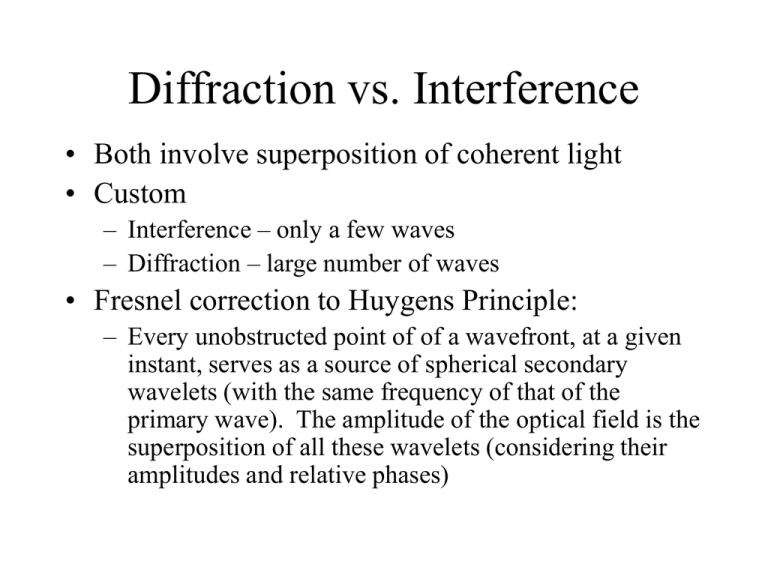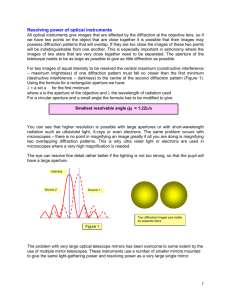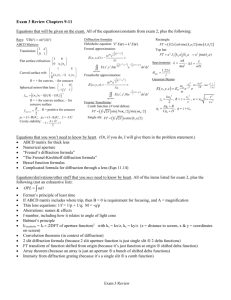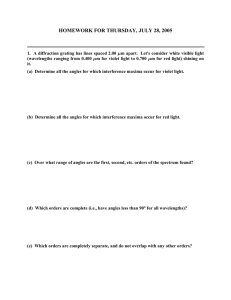Diffraction vs. Interference • Both involve superposition of coherent light • Custom
advertisement

Diffraction vs. Interference • Both involve superposition of coherent light • Custom – Interference – only a few waves – Diffraction – large number of waves • Fresnel correction to Huygens Principle: – Every unobstructed point of of a wavefront, at a given instant, serves as a source of spherical secondary wavelets (with the same frequency of that of the primary wave). The amplitude of the optical field is the superposition of all these wavelets (considering their amplitudes and relative phases) Fraunhofer vs. Fresnel • Fresnel – Diffraction is occurring near the aperture. a.k.a “near field diffraction” – Initially the fringe pattern looks like the aperture but then the pattern changes as the distance from the aperture increases. • Fraunhofer – Diffraction occurs far from the aperture. a.k.a “far field diffraction” – In this region the fringe pattern remains constant, changing only in size as distance from the aperture increases. Diffraction by edges Fig 38-2, p.1207 Single-Slit Diffraction • The finite width of slits is the basis for understanding Fraunhofer diffraction • According to Huygens’s principle, each portion of the slit acts as a source of light waves • Therefore, light from one portion of the slit can interfere with light from another portion Diffraction by a single slit Minima: a sin m m = 1,2,3,… Diffraction Pattern, Single Slit • The diffraction pattern consists of the central maximum and a series of secondary maxima and minima • The pattern is similar to an interference pattern Intensity • The light intensity at a point on the screen is proportional to the square of ER: sin β 2 I I max β 2 2 2π β a sin θ λ • Imax is the intensity at θ = 0 – This is the central maximum Combination of interference and diffraction for 2 slits Diffraction Interference Final Exam Problem 48 Light of wavelength 632 nm is incident on a single slit. The distance from the slit to a screen is 3 m. If the distance from the first minimum on one side of the center of the diffraction pattern to the first minimum on the other side is 8 mm, the width of the slit is closest to A. 0.22 mm screen B. 0.31 mm C. 0.47 mm D. 0.59 mm E. 0.66 mm 3m The Square Aperture y x 5 0 -5 1 0.8 0.6 0.4 Y 0.2 0 -5 0 5 X Circular Aperture I I 0 I I 0 1 1 Airy Pattern 0.8 0.8 0.6 0.4 0.6 0.2 -7.5 0.4 -5 -2.5 2.5 5 7.5 2 J1 a sin 0 0.2 4 2 0 0 -4 -2 2 a sin 3.83 -2 0 2 4 -4 ka sin sin 1.22 2a 1.22 D Circular apertures 1.22 D Rayleigh resolution criteria Rayleigh Criteria for Resolving Two Objects • Overlapping images from two apertures are just resolved when the center of one Airy disk falls on the first minimum of the other. I I 0 1 0.8 0.6 0.4 0.2 -7.5 -5 -2.5 2.5 l 5 7.5 ka sin Rayleigh resolution criteria slit a circ 1.22 D Resolution, Example • Pluto and its moon, Charon • Left: Earth-based telescope is blurred • Right: Hubble Space Telescope clearly resolves the two objects Final Exam Problem 49 A boat has lights on a mast that are 1 m apart. The dominant wavelength in the lights is 600 nm. The pupil in a person’s eye has an opening of 1 mm. For simplicity, we assume that the eye has a refractive index of 1. If the boat is closer, the person sees two lights on the mast. If the boat is farther away, the person sees only one light on the mast. The best value for the distance from the person to the boat is A. 1.4 km 1m B. 1.2 km C. 2.0 km D. 1.6 km E. 1.8 km Diffraction Grating Two slits Grating Maxima: dsin m Final Exam Problem 50 A beam of light is incident on a diffraction grating that has 600 lines/mm. The second order maximum occurs at a distance 0.7 m from the center of a screen that is 1.0 m from the grating. The wavelength of light is closest to: a. 478 nm b. 613 nm c. 574 nm grating 0.7 m d. 589 nm e. 542 nm 1.0 m Polarization “Linear” or “plane” polarization Vertically polarized Processes for accomplishing polarization: •selective absorption •reflection •double refraction •scattering Unpolarized? Horizontally polarized Polarization by Selective Absorption • The most common technique for polarizing light • Uses a material that transmits waves whose electric field vectors lie in the plane parallel to a certain direction and absorbs waves whose electric field vectors are perpendicular to that direction Polarizing Sheets – Selective absorption Io I 2 Law of Malus: I I o cos 2 Polarization by reflection Brewster’s Angle: n2 tan p n1 Polarization by Double Refraction • Unpolarized light splits into two planepolarized rays • The two rays are in mutual perpendicular directions – Indicated by the dots and arrows Polarization by Scattering, Rayleigh Scattering • The horizontal part of the electric field vector in the incident wave causes the charges to vibrate horizontally • The vertical part of the vector simultaneously causes them to vibrate vertically • If the observer looks straight up, he sees light that is completely polarized in the horizontal direction Iscattered 1 4 Final Exam Problem 37 When unpolarized light is passed through two polarizing filters in succession, its intensity is decreased by 80%. The angle, , between the transmission axis of the filters is A. 78.5 degrees B. 63.4 degrees C. 26.6 degrees D. 36.9 degrees I=0.2Io E. 50.8 degrees Polaroids 3. A screen is placed 50.0 cm from a single slit, which is illuminated with 690-nm light. If the distance between the first and third minima in the diffraction pattern is 3.00 mm, what is the width of the slit? 6. Light of wavelength 587.5 nm illuminates a single slit 0.750 mm in width. (a) At what distance from the slit should a screen be located if the first minimum in the diffraction pattern is to be 0.850 mm from the center of the principal maximum? (b) What is the width of the central maximum? 18. A binary star system in the constellation Orion has an angular interstellar separation of 1.00 × 10–5 rad. If λ = 500 nm, what is the smallest diameter the telescope can have to just resolve the two stars? 41. Plane-polarized light is incident on a single polarizing disk with the direction of E0 parallel to the direction of the transmission axis. Through what angle should the disk be rotated so that the intensity in the transmitted beam is reduced by a factor of (a) 3.00, (b) 5.00, (c) 10.0? 45. The critical angle for total internal reflection for sapphire surrounded by air is 34.4°. Calculate the polarizing angle for sapphire.







